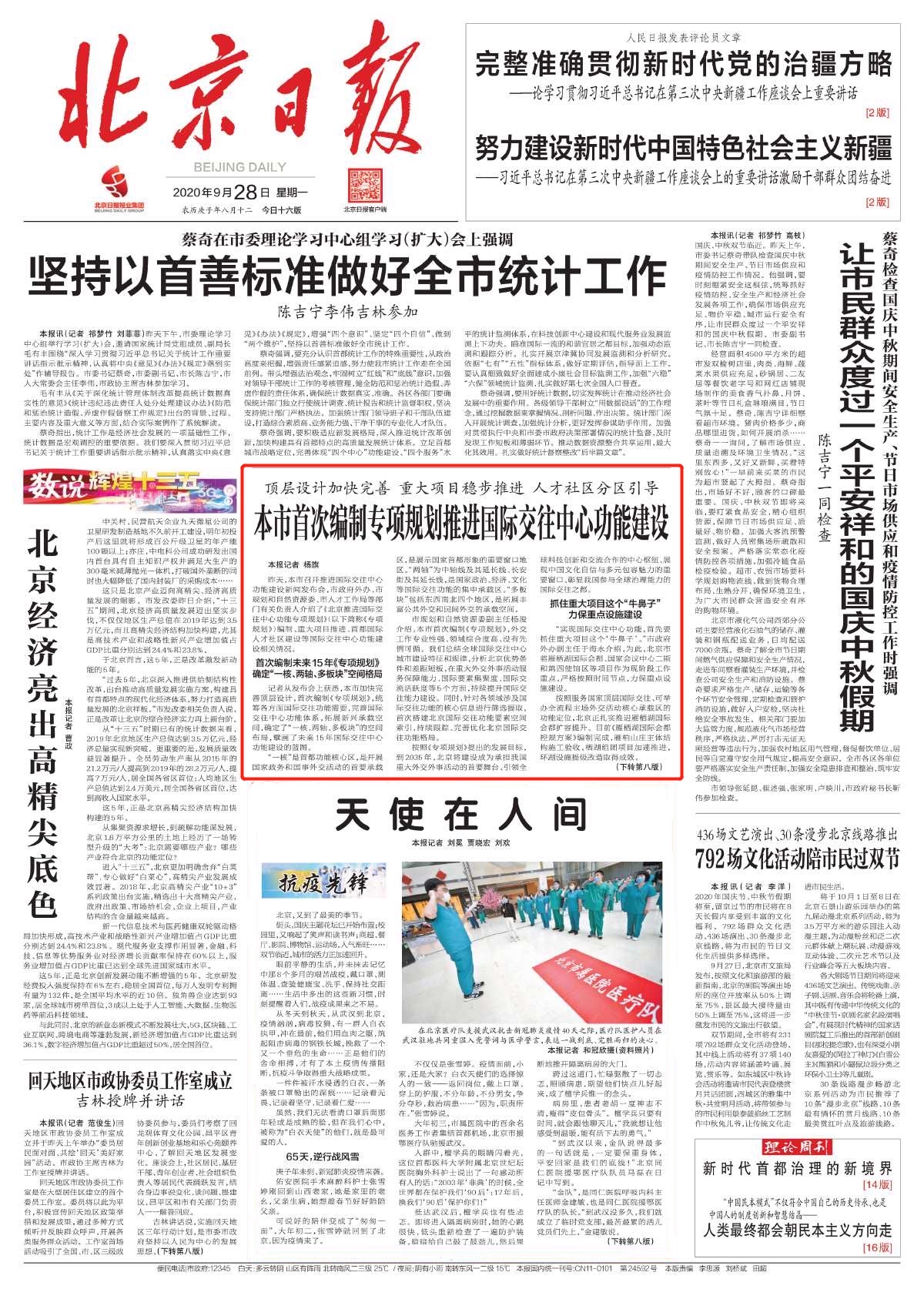
On September 27, Beijing held a press conference on improving its role as the center for international exchanges. Persons in charge of the Foreign Affairs Office of the People's Government of Beijing Municipality, Beijing Municipal Commission of Planning and Natural Resources, and Beijing Talent Work briefed on the preparation of the specialized plan, the progress in major projects and the building of communities for foreigners with professional skills, among other areas of work.
The first 15-year specialized plan maps out a spatial pattern of “one core, two axes and multiple sections”
The first-ever Specialized Plan for Improving Beijing's Role as the Center for International Exchanges is a result of Beijing's accelerated efforts to improve top-level design. Taking into account the needs for international exchanges in various fields, the plan maps out a blueprint for the building of a center for international exchanges in the coming 15 years and puts forth a spatial pattern of “one core, two axes and multiple sections” to improve the system and open up new spaces for international exchanges.
“One core” refers to the core functional area for state and diplomatic events, which serves as an important window to demonstrate the image of the capital city. The “two axes,” namely the Central Axis and the Chang'an Avenue and its extensions, are where most international exchanges occur in political, economic and cultural aspects. The “multiple sections”, namely the eastern, western, southern and northern sections, are areas for expanding and enriching public and people-to-people diplomacy.
According to Yang Jun, Deputy Director-General of Beijing Municipal Commission of Planning and Natural Resources, developing the specialized plan involves extensive diplomatic knowledge and a wide range of sectors, and there are no precedents to follow. She said, after summarizing the features and rules of development of cities as centers for international exchanges around the world and analyzing the strengths and weaknesses of Beijing, we decided to improve the city's role as a center for international exchanges in five aspects such as the service capabilities for major diplomatic events, gathering of international elements and involvement of international exchanges. Meanwhile, we sort out key information related to international exchanges in various fields to build the first spatial index of elements key to the role and will keep track of and continuously improve the functional pattern.
According to the goals set in the plan, by 2035, Beijing will become a primary stage for major diplomatic events in China, a world-leading hub for sci-tech innovation and cooperation, an important window that demonstrates China's cultural confidence, inclusiveness and charm, and a center for international exchanges that reflects China's strengths in global governance.
Focusing on major projects to ensure smooth progress in the construction of key facilities
“To improve the role as center for international exchanges, we should first of all focus on major projects,” said Yu Haiyong, Deputy Director-General of the Foreign Affairs Office of the People's Government of Beijing Municipality. The key projects high on the city's agenda include the Yanqi Lake International Conference Resort, the National Convention Center Phase II and the fourth embassy zone. Efforts will be made to ensure that the key facilities are completed on schedule.
Beijing is now advancing the expansion and upgrade of the Yanqi Lake International Conference Resort to build it into a core area for high-level international exchanges and diplomatic events. Up to now, the Regulatory Plan for the Yanqi Lake International Conference Resort has been drafted, the main structures of Yanbai Manor have been completed and accepted, the Qihu Lake cluster project has made great strides, and solid results have been achieved in the improvement of facilities around the lake.
Yu also gave an update on the National Convention Center Phase II, a new venue for international exchanges. With its main structure already capped, the complex is expected to be put into use next year. In addition, the Regulatory Plan and Urban Design for the Fourth Embassy Zone has been implemented, and the construction of urban infrastructure and improvement of surrounding environment have been advanced, with the aim of building a “second Sanlitun”. Smooth progress has been made in the Beijing Daxing International Airport Economic Zone, the New China International Exhibition Center Phase II and III, the Universal Beijing Resort, and the venues for the Beijing 2022 Olympic and Paralympic Winter Games.
District-based guidance to the building of communities for foreign talents
In recent years, Beijing has successively started the building of eight communities for foreign talents, including Wangjing in Chaoyang District, Zhongguancun Science City and Future Science City. The Guidelines on the Building of Communities for Foreign Talents in Beijing (Trial) released this year contains an indicator system for nine scenarios, laying down the standards and basis for advancing work in this area.
In view of balancing the common requirements and diversities of different communities, the city, based on the Guidelines, worked out specific plans for the eight communities according to their respective development features.
According to Liu Minhua, Deputy Director-General of Beijing Talent Work, the Guidelines consists of four parts, of which the second and third parts elucidate the common standards and individual differences, respectively. The second part puts forth the “1+3+9” top-level design approach. “1” refers to the requirements of international talent, which is the core of the concept. “3” refers to the “internationalized, eco-friendly and digitalized” principles and building concepts. “9” refers to nine scenarios of concern to these professionals, such as livable communities, neighborly relations, education and culture, innovation services, healthcare, and transportation network.
Based on the nine scenarios, the Guidelines proposes 115 indicators in 33 subgroups that falls under nine categories. These indicators are not developed by pursuing a one-size-fits-all approach, said Liu. Some are obligatory targets that must be met to be internationalized, and some are anticipated indicators designed to guide the building of communities for foreigners with professional skills based on their diversified resources and development characteristics.
“For example, we focus on improving and upgrading existing communities in Wangjing and Zhongguancun Science Park, integrating international elements to communities under construction in Shunyi District and Beijing Economic-Technological Development Area, and charting the way for New Shougang Park and Huairou Science Park,” said Liu. “We hope to combine the general requirements with their resources and exploit their respective strengths to build differentiated communities with common standards and attract more talents across the globe to Beijing.”
(Reporter: Yang Qi)


